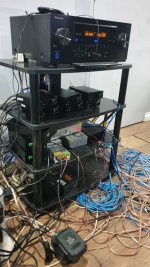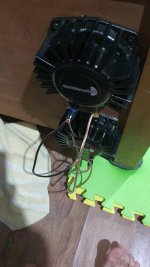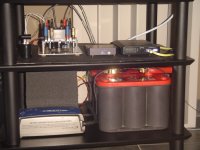Hope its clear from the pic . I spent the last 2 months reducing RFI . I have succeeded using multiple technics and shields .
I see you are using, as confirmed, air core coil inductors

Are you using Polymer Hybrid Aluminum Electrolytic Capacitors as well ?
I did not remember what you said about OP amps on your modules ?
Thanks for the picture, nice Bro ! 🙂
Yes air core inductors. Simply the best for SQ. No magnetic hysteresis but much harder to tame if hardware has to pass emission certification .. (and we intend to pass it)
The polymer cap is used for Avdd (its visible) 1000uF.
We are using OPA2156 (a slight variant of 1656) and FDA opamp in the buffer .
The polymer cap is used for Avdd (its visible) 1000uF.
We are using OPA2156 (a slight variant of 1656) and FDA opamp in the buffer .
GoodWe are using OPA2156 (a slight variant of 1656) and FDA opamp in the buffer .
I have showed the inductors (L) to make it clear that we are pursuing one thing only...sound quality .
In fact , you are listening to your L (biggest source of non linearity, good capacitors are by far more linear ) . The magnetic hysteresis (aircore has almost none) has been found to impact SQ and everyone solves it using lots of feedback.
The maths on feedback are iron clad, but I always taught , for best SQ you have to solve the issue at its root. In other words , solve non linearity by best design and use feedback to slightly correct (instead of massively correct, non linearity ) , especially in Class D with square waves at 500-700Khz ..
There are/were a few class D using aircores and all were/are reputed to have great SQ. From what I understood they also had lots of harmonics..Simply this amp takes the idea of aircores and integrates it to a system that has extremely low harmonics (to begin with )
drmordor , I have showed multiple times my test data. I have also showed the air cores inductors ..
One last thing. Class D needs good power . LLC smps are by design , low noise /plenty of power ( I have tested multiple LLCs) but not negligible . Can someone with any tpa3255 remove LLC and with a very short connection and thick wire(low impedance ) connect it to a 48V battery.TPA3255 will gain in SQ.
In fact , you are listening to your L (biggest source of non linearity, good capacitors are by far more linear ) . The magnetic hysteresis (aircore has almost none) has been found to impact SQ and everyone solves it using lots of feedback.
The maths on feedback are iron clad, but I always taught , for best SQ you have to solve the issue at its root. In other words , solve non linearity by best design and use feedback to slightly correct (instead of massively correct, non linearity ) , especially in Class D with square waves at 500-700Khz ..
There are/were a few class D using aircores and all were/are reputed to have great SQ. From what I understood they also had lots of harmonics..Simply this amp takes the idea of aircores and integrates it to a system that has extremely low harmonics (to begin with )
drmordor , I have showed multiple times my test data. I have also showed the air cores inductors ..
One last thing. Class D needs good power . LLC smps are by design , low noise /plenty of power ( I have tested multiple LLCs) but not negligible . Can someone with any tpa3255 remove LLC and with a very short connection and thick wire(low impedance ) connect it to a 48V battery.TPA3255 will gain in SQ.
If powered from a nuclear reactor, the sound will become divine))) Almost like my GaN amplifier)))Can someone with any tpa3255 remove LLC and with a very short connection and thick wire(low impedance ) connect it to a 48V battery.TPA3255 will gain in SQ.
Yes air core inductors. Simply the best for SQ. No magnetic hysteresis but much harder to tame if hardware has to pass emission certification .. (and we intend to pass it)
The polymer cap is used for Avdd (its visible) 1000uF.
We are using OPA2156 (a slight variant of 1656) and FDA opamp in the buffer .
Thanks a lot for your transparency )
Maybe you already answered.... If I'm not mistaken the final version will be a ready-to-use amplifier ? (finished amp)
IF yes : are you going to isolate the PSU (like Aiyima for example)? I think this is the most suitable option to isolate interferences and optimize noise.
In fact I would like to see on the market a very good TPA3255 but without PSU, that we have the possibility of choosing it in the end !)
Last edited:
Yes I am making a finished amp in casing. Yes I am using separate PSU (with full body shield )
I was suggesting to use a battery to make my second point.
As great as LLC is (bydesign) , we went a step further. Our goal was to beat 5uV of noise(0-20Khz and make sure that SW frequency of LLC was not a exact divider of Amp switching ). I am happy to say we are at 1uV of noise (not very far from batteries) at multiple A.
Yes GanFets are wonderful but a Mosfet with correct snubber has a waveform thats very much the same. I still think that L is most important in SQ. That and low noise/impedance psu 🙂
I was suggesting to use a battery to make my second point.
As great as LLC is (bydesign) , we went a step further. Our goal was to beat 5uV of noise(0-20Khz and make sure that SW frequency of LLC was not a exact divider of Amp switching ). I am happy to say we are at 1uV of noise (not very far from batteries) at multiple A.
Yes GanFets are wonderful but a Mosfet with correct snubber has a waveform thats very much the same. I still think that L is most important in SQ. That and low noise/impedance psu 🙂
Hello,
I used battery power 12 and 24 volts (Optima Red Top) for almost 10 years
About 2 years ago i changed for a MW LRS-350-48 power supply on my TPA3255EVM
It will surely measure better with the gel batt. but for my ears the difference was not audible
My wife was very pleased that finally those Red Tops plus charger left the livingroom
😉
Enjoy...
I used battery power 12 and 24 volts (Optima Red Top) for almost 10 years
About 2 years ago i changed for a MW LRS-350-48 power supply on my TPA3255EVM
It will surely measure better with the gel batt. but for my ears the difference was not audible
My wife was very pleased that finally those Red Tops plus charger left the livingroom
😉
Enjoy...
Hope its clear from the pic . I spent the last 2 months reducing RFI . I have succeeded using multiple technics and shields .
Can you make a version with Toslink in?
//
Hello chips
Impedance is important . Did you use 3 or 4 batteries in series (impedance is added 3-4 times ) ? Did you use short cables /thick gauge ? Did you have the charger plug in when you were listening ?
Second is impedance at 450/600Khz (switching frequency ). If your batteries had low impedance/short wires , no charger , I would suggest that decoupling caps are not adequate(since batteries impedance in 450Khz is poor) (TI datasheet design is also not adequate). No matter how clean your power is , if your decoupling caps don't do theirs job , you will have lots of ringing and gnd bouncing that will render the battery power , immaterial .
Of course , there is always the possibility that PSU is not important . Frankly I am not someone that believes/hears that. Quite the opposite . In small signals devices , analog or digital , we find that a very well designed Dac or digital transporter , is very sensitive (or slightly at least) to power input...even after using 2 LDOs in series (psrr of 180)..how is that possible ? My rule is...once you have garbage inside , it will always stink (even if garbage attenuation is very good)
In a well designed AMP , battery power will sound ...good. (in reality you can never have battery and smps at same impedance over frequency but lets say you do ,the battery will still sound better) . Galvanic isolation 😀
You hear it , she/he hears it not ..what is the truth. None , to each his own .
Impedance is important . Did you use 3 or 4 batteries in series (impedance is added 3-4 times ) ? Did you use short cables /thick gauge ? Did you have the charger plug in when you were listening ?
Second is impedance at 450/600Khz (switching frequency ). If your batteries had low impedance/short wires , no charger , I would suggest that decoupling caps are not adequate(since batteries impedance in 450Khz is poor) (TI datasheet design is also not adequate). No matter how clean your power is , if your decoupling caps don't do theirs job , you will have lots of ringing and gnd bouncing that will render the battery power , immaterial .
Of course , there is always the possibility that PSU is not important . Frankly I am not someone that believes/hears that. Quite the opposite . In small signals devices , analog or digital , we find that a very well designed Dac or digital transporter , is very sensitive (or slightly at least) to power input...even after using 2 LDOs in series (psrr of 180)..how is that possible ? My rule is...once you have garbage inside , it will always stink (even if garbage attenuation is very good)
In a well designed AMP , battery power will sound ...good. (in reality you can never have battery and smps at same impedance over frequency but lets say you do ,the battery will still sound better) . Galvanic isolation 😀
You hear it , she/he hears it not ..what is the truth. None , to each his own .
Can you make a version with Toslink in?
//
TPA3255 is analog in (not digital). There is a TAS part that accepts digital
TPA3255 is analog in (not digital). There is a TAS part that accepts digital
You can still use a DAC 😀
TPA3255 is analog in (not digital). There is a TAS part that accepts digital
A version with that chip from you?
//
Yes I am making a finished amp in casing. Yes I am using separate PSU (with full body shield )
I was suggesting to use a battery to make my second point.
As great as LLC is (bydesign) , we went a step further. Our goal was to beat 5uV of noise(0-20Khz and make sure that SW frequency of LLC was not a exact divider of Amp switching ). I am happy to say we are at 1uV of noise (not very far from batteries) at multiple A.
Yes GanFets are wonderful but a Mosfet with correct snubber has a waveform thats very much the same. I still think that L is most important in SQ. That and low noise/impedance psu 🙂
whatever your choices, keep it at a democratic price please )
A version with that chip from you?
//
I think we can do much better than TAS...but I need to build and take test data..
Hi guys i bought the no name. China tpa3255 that looks very similar to the aiyima a07 hand have them powered with 48v 7.2a, 48v 10a, 48v 12.5a. And tried doing a cinewave 50hz signal and measured the volts powering my dayton bst-1 bass shakers in parrallel for a total of 2ohm load at referrence volume levels with a multimeter and it only came in at 8.3 volts at 1amp wth.... so my shakers are just getting 8 watts divided by 2 so 4 watts each? What gives? I need 50 watts at 4 ohm rms for each shaker. Did I do anything wrong or are the china boards not giving out enough power? Bought a couple of tpa3116d2 dual chip boards to test out if the results are the same. Or is a multimeter not accurate to test for amp watrage?




I think we can do much better than TAS...but I need to build and take test data..
Well, a small, one channel, high quality say 50-100W module that can be connected via opto (toslink) would be very usable 🙂
//
D
Deleted member 148505
My TICORE260BTL'S noise is in nVrms range (0-20kHz) when I use A Weighting and 8 ohms load. But I don't trust my QA400 setup. Independent test is needed.
Hello chips
Impedance is important . Did you use 3 or 4 batteries in series (impedance is added 3-4 times ) ? Did you use short cables /thick gauge ? Did you have the charger plug in when you were listening ?
Second is impedance at 450/600Khz (switching frequency ). If your batteries had low impedance/short wires , no charger , I would suggest that decoupling caps are not adequate(since batteries impedance in 450Khz is poor) (TI datasheet design is also not adequate). No matter how clean your power is , if your decoupling caps don't do theirs job , you will have lots of ringing and gnd bouncing that will render the battery power , immaterial .
Of course , there is always the possibility that PSU is not important . Frankly I am not someone that believes/hears that. Quite the opposite . In small signals devices , analog or digital , we find that a very well designed Dac or digital transporter , is very sensitive (or slightly at least) to power input...even after using 2 LDOs in series (psrr of 180)..how is that possible ? My rule is...once you have garbage inside , it will always stink (even if garbage attenuation is very good)
In a well designed AMP , battery power will sound ...good. (in reality you can never have battery and smps at same impedance over frequency but lets say you do ,the battery will still sound better) . Galvanic isolation 😀
You hear it , she/he hears it not ..what is the truth. None , to each his own .
The Altmann BYOB amplifier
Hi,
I used to own an Altmann amp and dac, both powered by battery 12 volt
When i later started with class D i kept the battery and when higher voltage was needed i went for 2 Optima Red Top 50ah in series
Kept the wiring as short as possible and charger CTEC connected as i could not hear a difference With TPA3255EVM i first used 24 volts but did not want to use 3 or 4 batteries for 36 or 48 volts
To dangerous in a livingroom and my wife was already complaining WAF 😉
Thats why i bought the MW LRS-350-48 supply
I was a longtime battery power believer but my ears could not detect a difference when i switched back to SMPS power
Never did any measurements but my hearing also changed getting older 🙂
Rgds
Ronny
Attachments
- Home
- Amplifiers
- Class D
- TPA3255 - all about DIY, Discussion, Design etc
